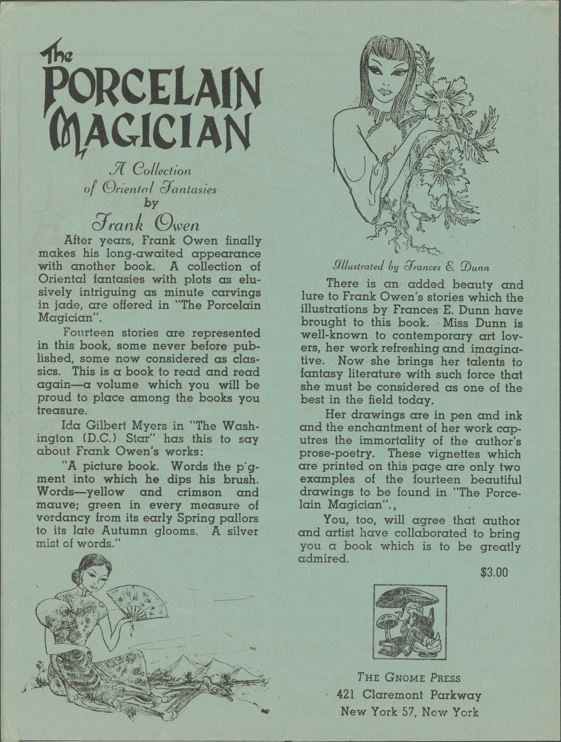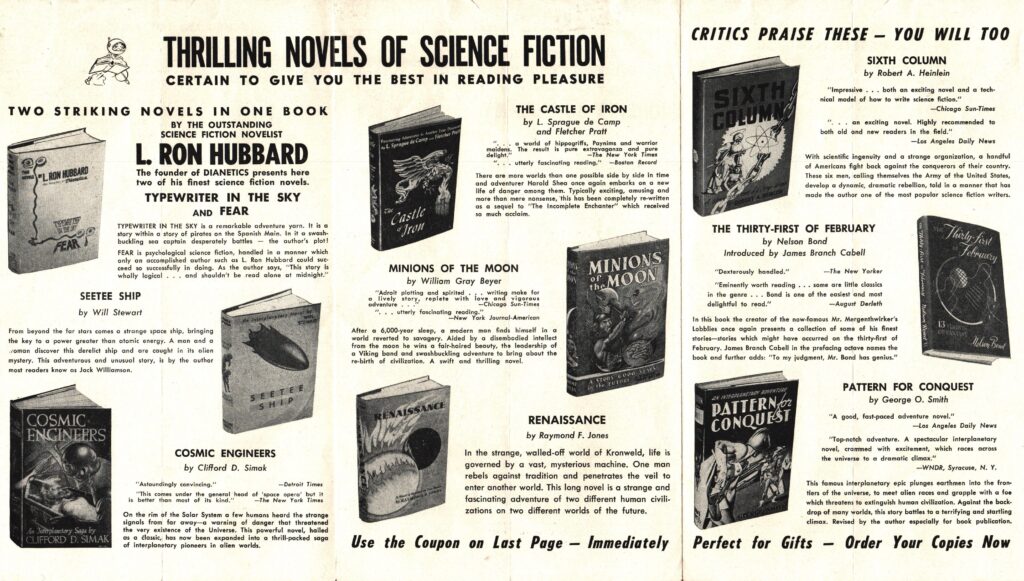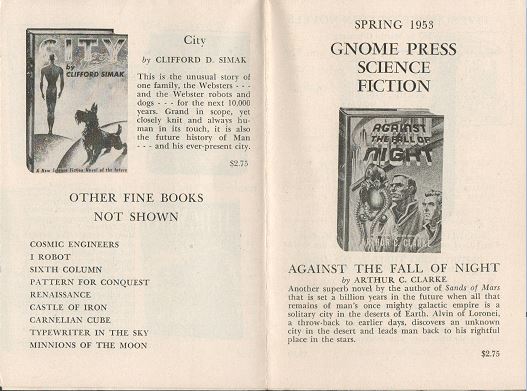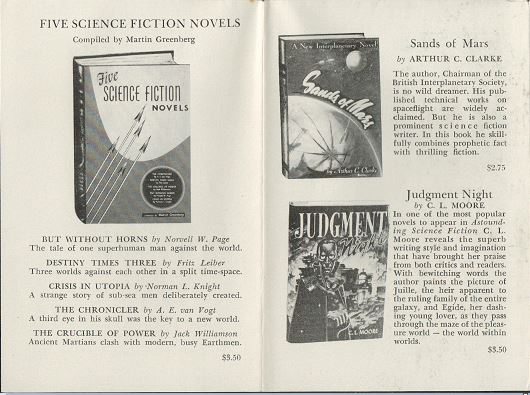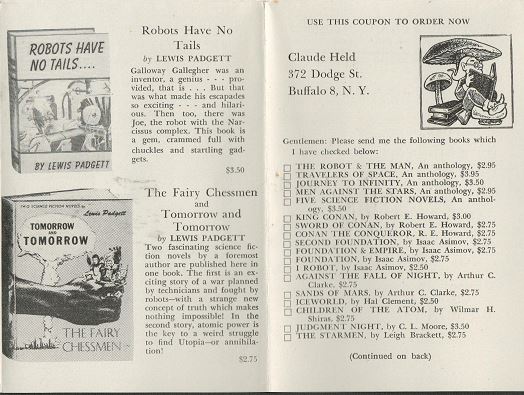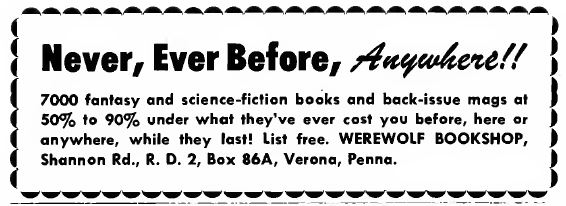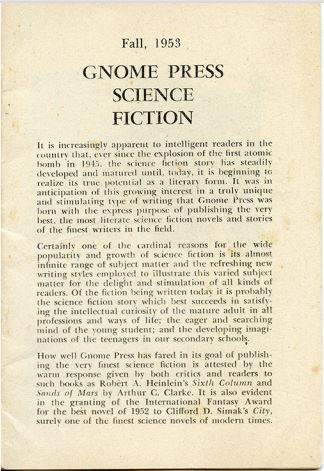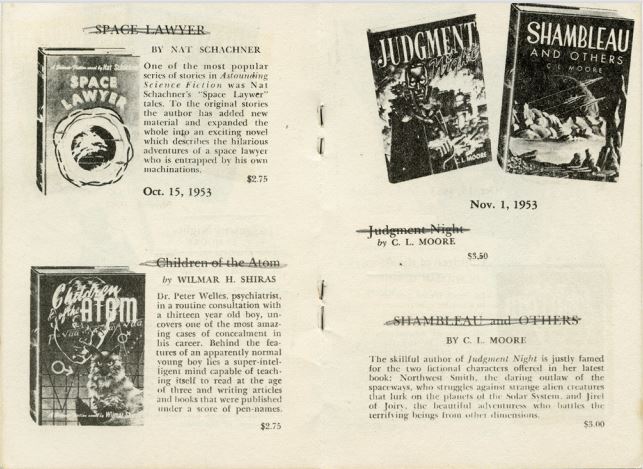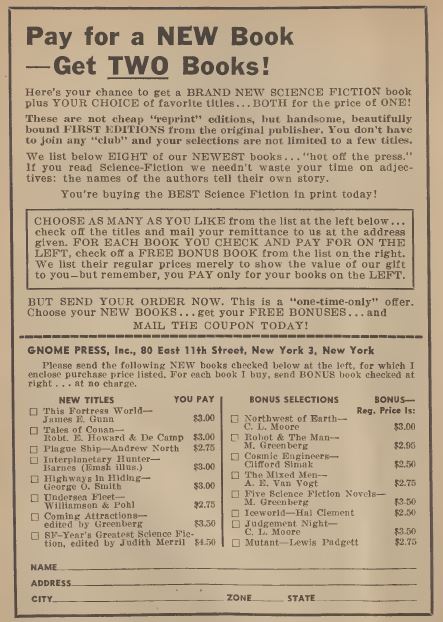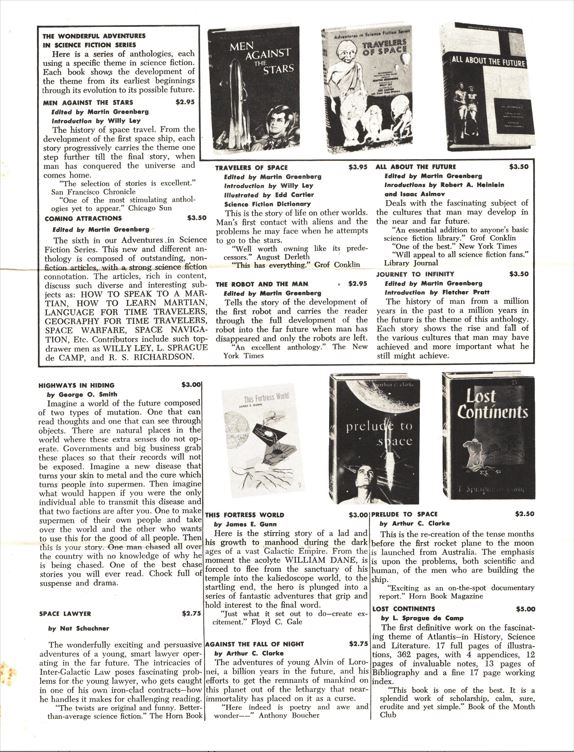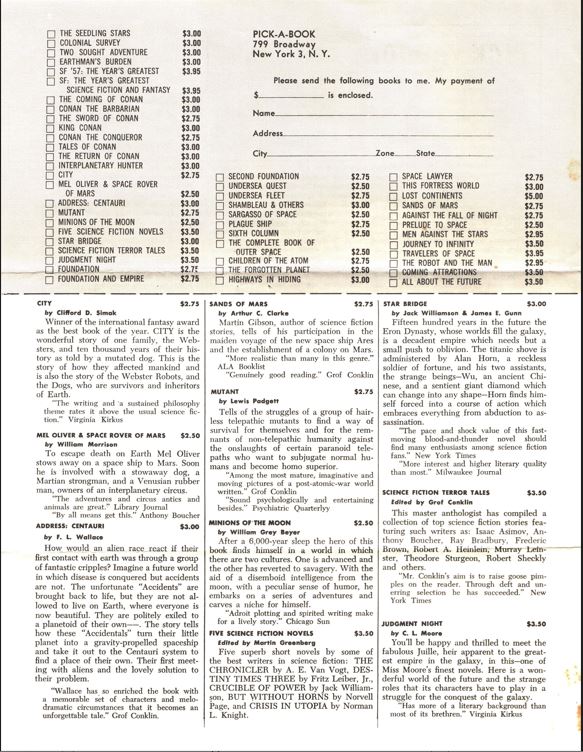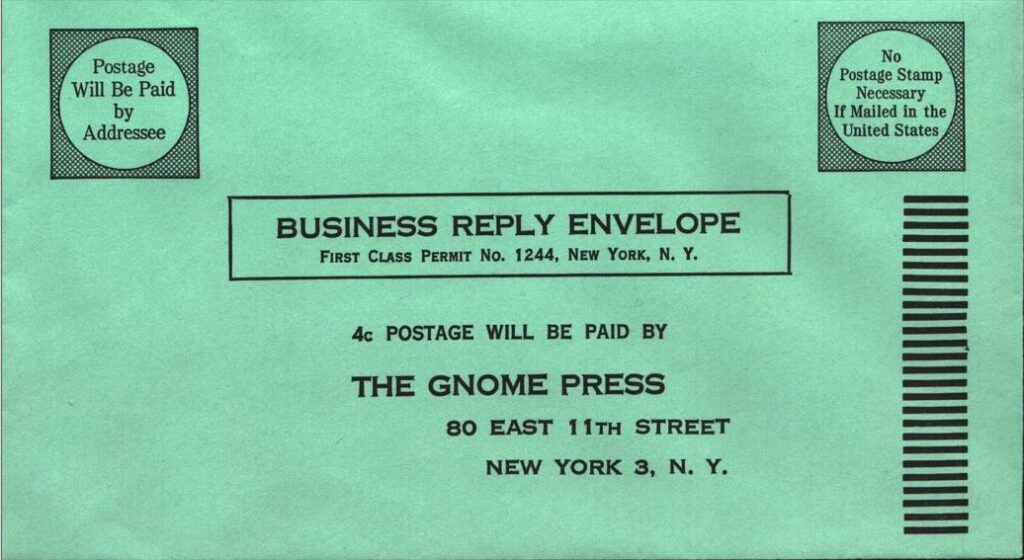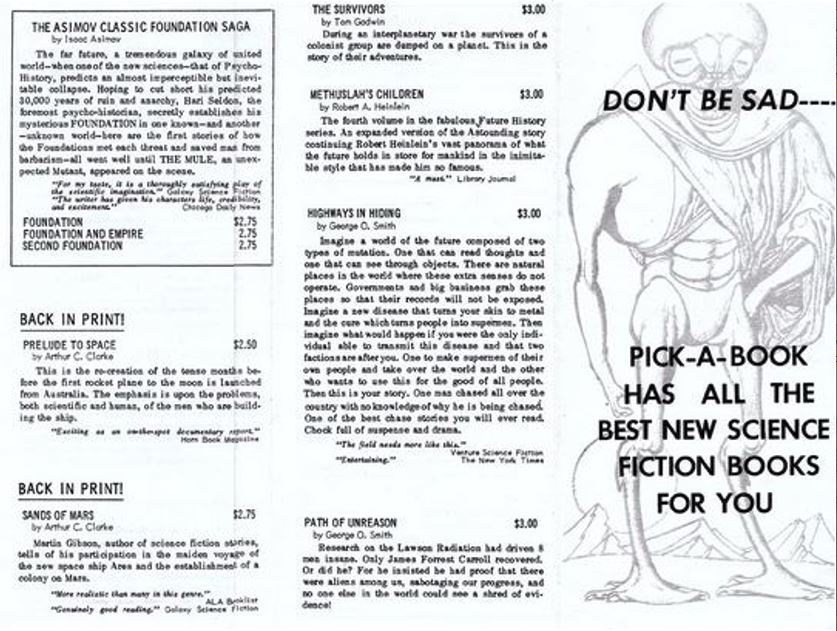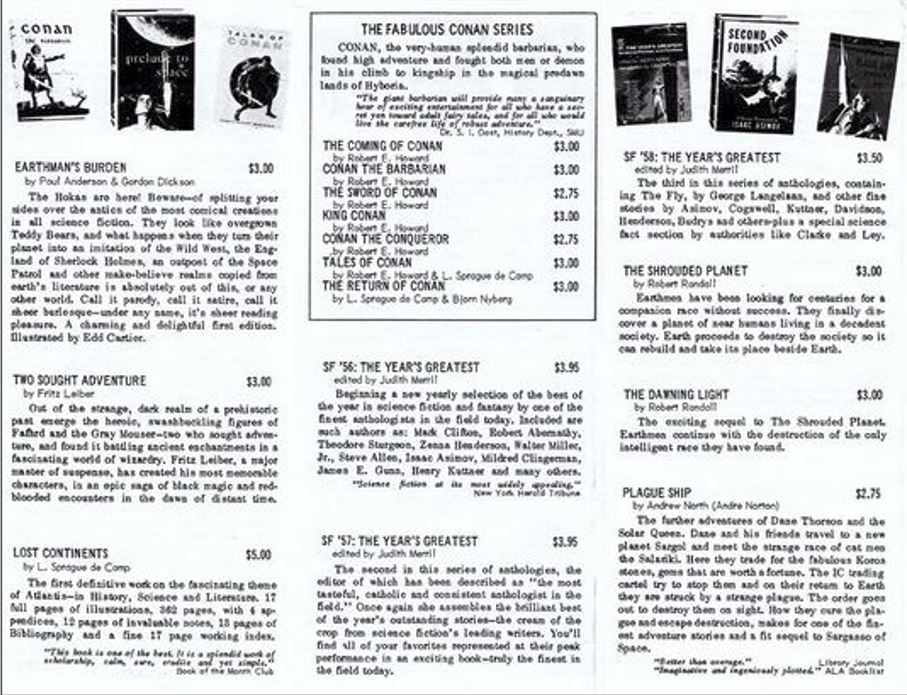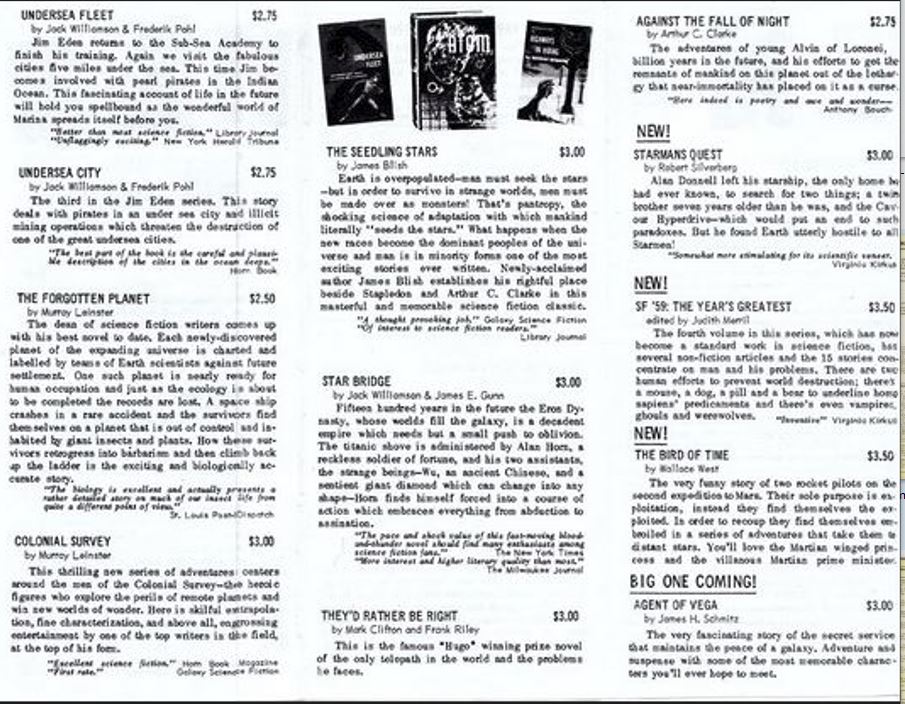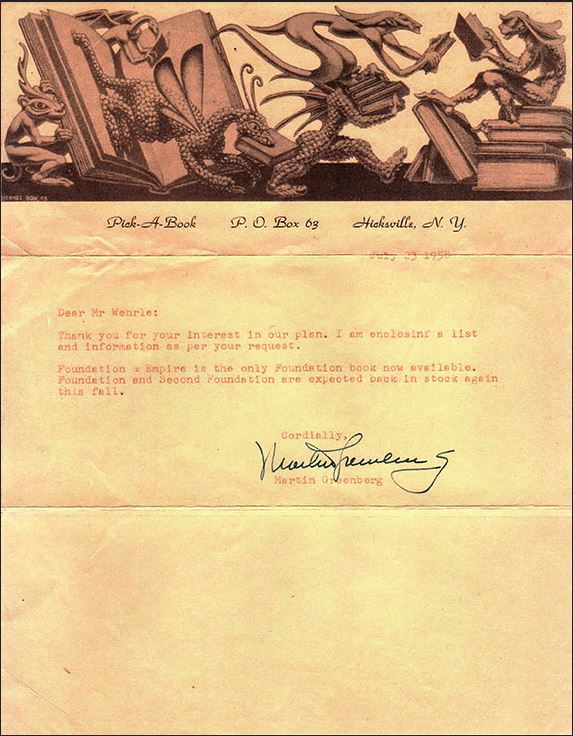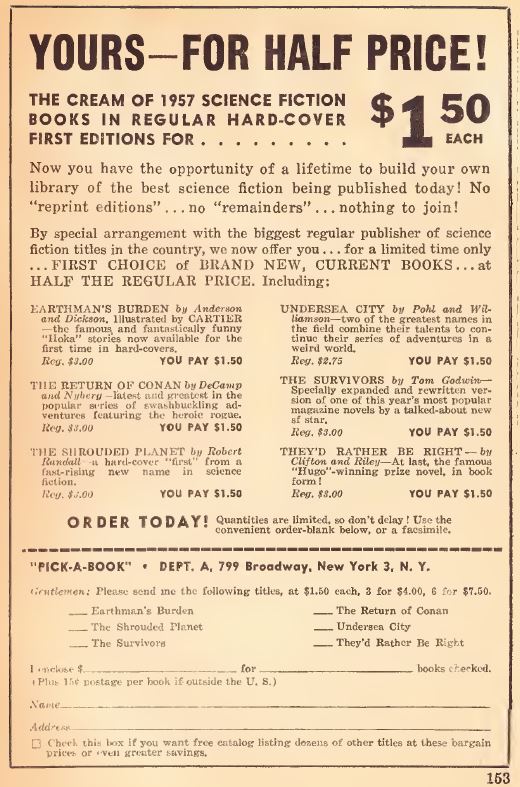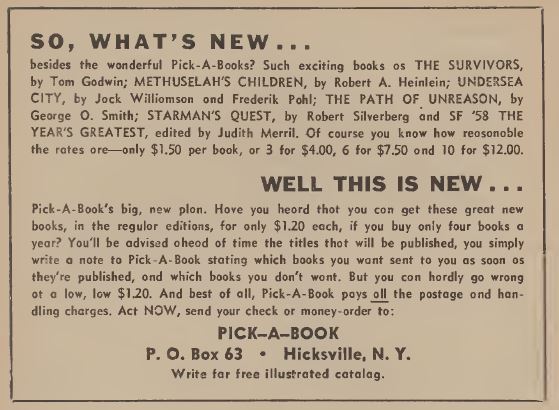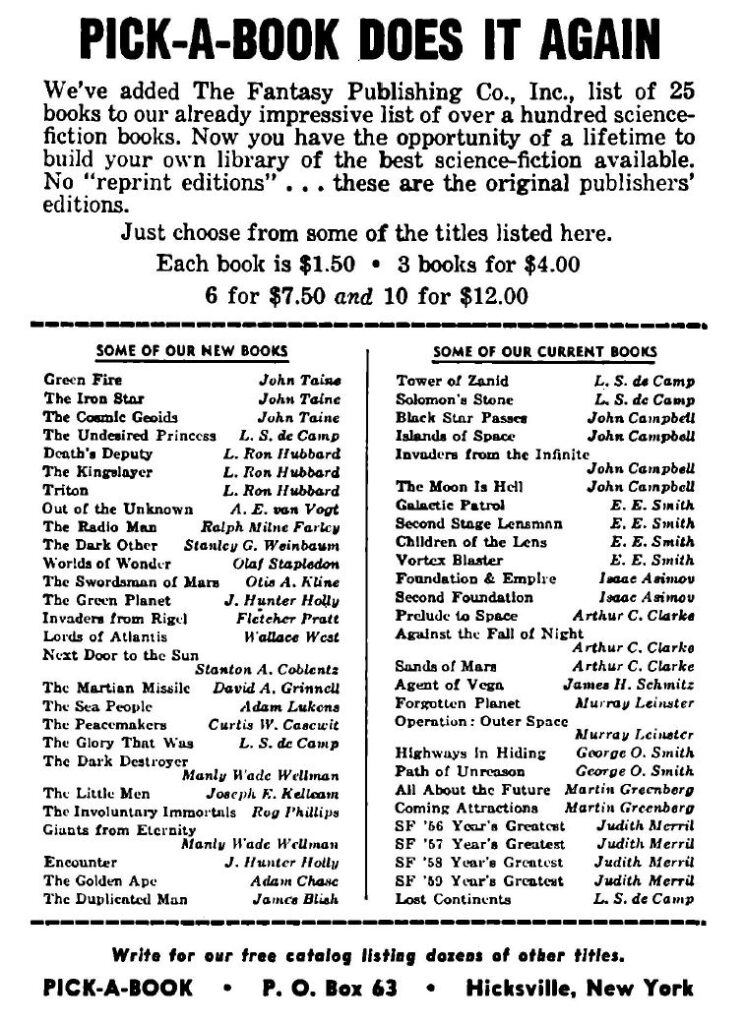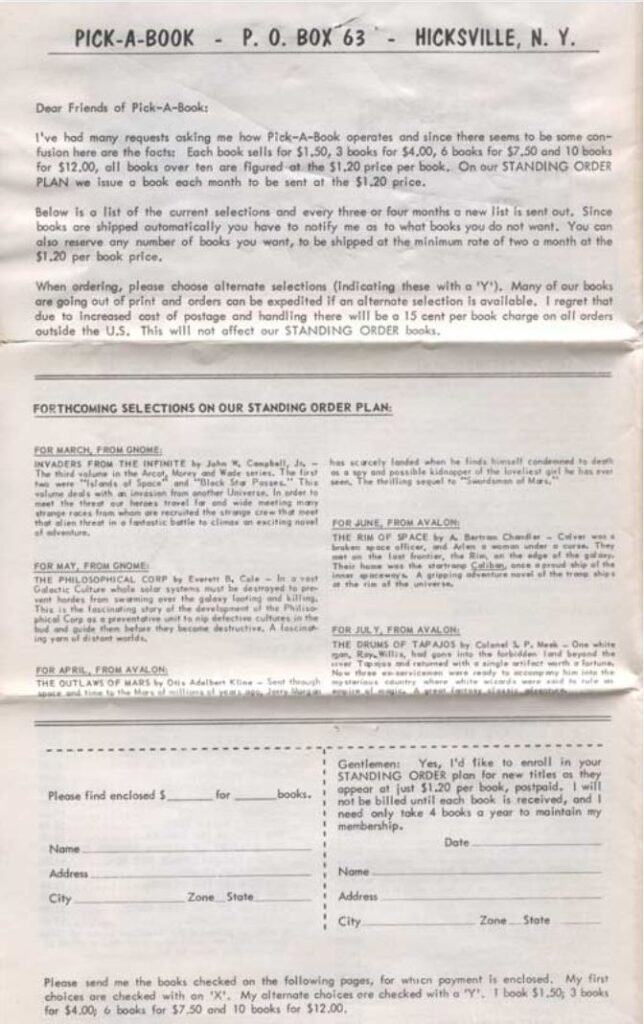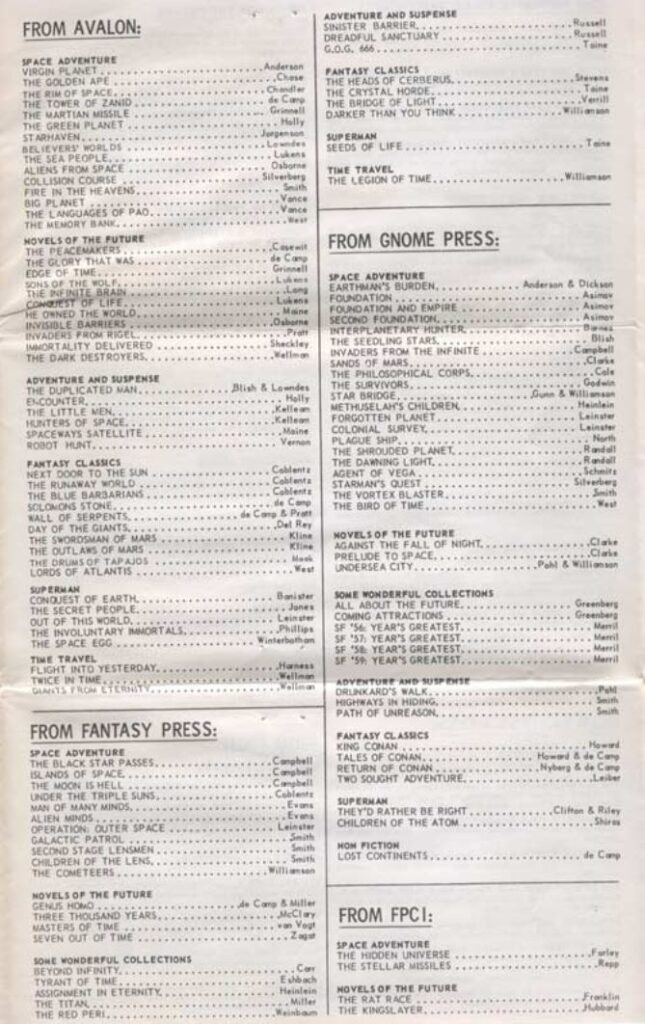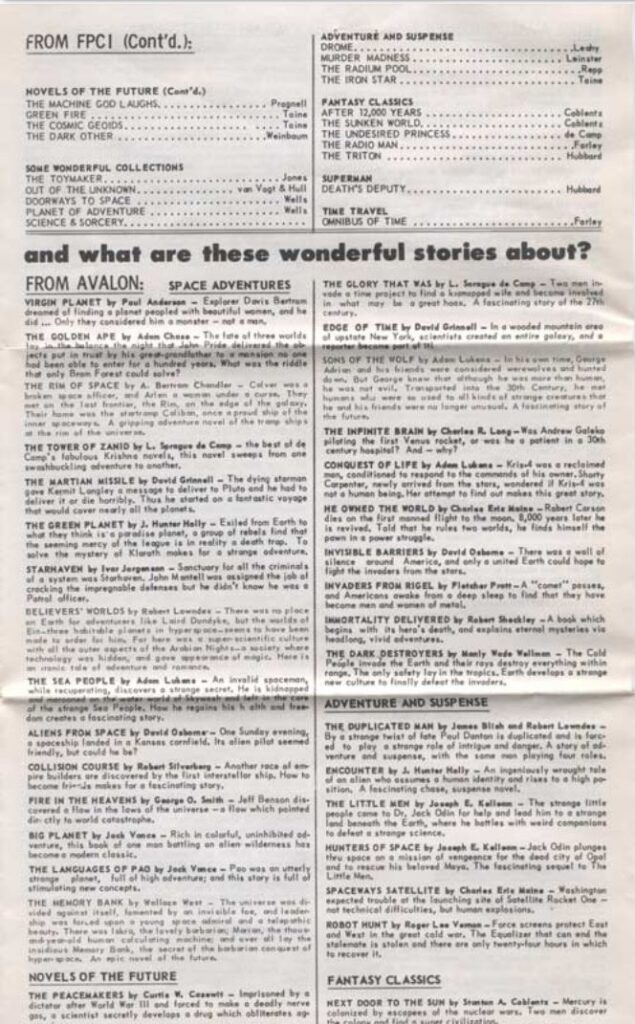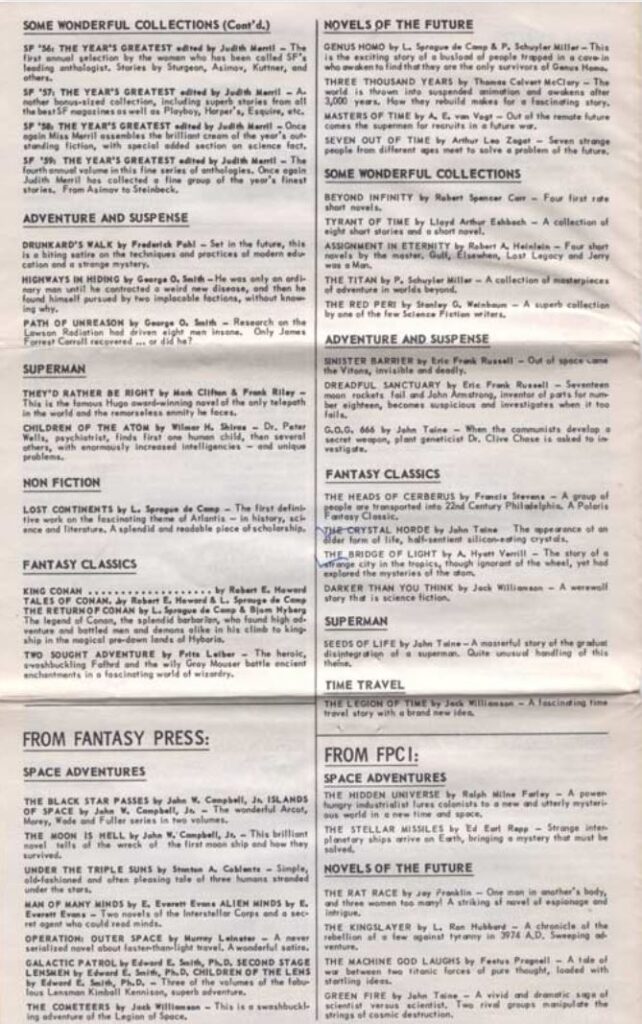Catalogs are a small and virtually unknown part of the life of the small f&sf specialty publishers. Several presses released advertising flyers in the late 1940s, most listing not more than a half dozen titles. Gnome did better than that. Its first catalog gave buyers a choice of seventeen books, including some of the all-time classics of the field.
First, though, came the advertising sheets. KEMP lists an “Advertising Flyer Spring 1950.” The image is simply the cover of Travelers of Space, printed on both sides of a single sheet of paper. Much nicer is the one-page, double-sided sheet of blue paper for The Porcelain Magician, Gnome’s second release, filled with extravagant promotional hype that should have sold many copies. The back side lists only Pattern for Conquest and The Thirty-first of February as forthcoming books, more evidence if anyone needed it that Sixth Column was not the third Gnome title, as ESHBACH has it.

The Gnome Press Records at Syracuse University lists two more similar early sheets:
Double sided white 4 page early 1950 – Castle of Iron forthcoming
Double sided white 6 pages late 1950, through Journal to Infinity but coming in Nov. 1950
The first true catalog we know about appeared in 1951. An extra-large sheet at 8.5” x 15”, folded in thirds, listed a full seventeen titles on the order form, showing how quickly Gnome grew into a powerhouse. To entice readers, the first page visible proclaimed the news that several titles were scheduled for the fall of 1951: Foundation (due in September), The Fairy Chessmen and Tomorrow and Tomorrow (due in August), and The Sword of Conan (due in November); when readers flipped over the folded side, another headline informed that Travelers of Space was also due in November. Gnome’s forthcoming dates were consistently overoptimistic. Foundation got out the door in September, according to its copyright date, but the other three had copyrights of December 1951, April 1952, and January 1952 respectively.

1953 saw two catalogs, a Spring and a Fall, in identical formats. The Spring 1953 catalog consisted of a single 10.5” x 14” sheet folded in eighths, down to 3.5″ x 5.25″. The odd format provided room for a few extra square inches of display space, but folded down to shirt pocket size, making it easy to lose or displace. An additional oddity is that the order address for the now 30 titles was to Claude Held in Buffalo, NY. Held had been selling f&sf since 1939 and regularly advertised his “thousands of fantasy books and magazines” in fanzines. (He later saw the coming boom in Golden Age comic books. The February 1965 Hyphen contains an article in which the writer marvels that he and his wife “were chuckling one night a few weeks back over the latest price-list from Claude Held, a New York comic-book dealer, which solemnly listed a Batman No.1 for thirty dollars…” Of course, Gnome titles were selling for a dollar each at that time.) Why Held was asked to do fulfillment 400 road miles away from Gnome’s office full of unsold books is another Gnome mystery.
So the decision to dump Held and move to a different fulfiller 360 miles away only a few months later with the Fall 1953 calendar can’t be explained by convenience or distance.
Robert Michael ran the Werewolf Bookshop from Verona, PA, outside of Pittsburgh. Seemingly a mail-order operation with no physical bookshop, ads for the company began appearing in Weird Tales in the late 1940s. (A possibly affiliated Werewolf Lending Library in Pittsburgh began inserting classified ads in Weird Tales in 1939.) By 1953 better looking ads were a regular in Astounding. And in the December 1954 issue, Michael ran this mouth-watering ad..
Sound too good to be true? It might have been. Think of the profit if you just took in money without delivering product. By the end of the decade fans loudly complained that Michael ran constant ads claiming that he was being called up in the Army and needed to close out his stock, selling $100 worth for $6. People bit. They received, if anything, a few junk titles not related to their order. In 1964 Michael was jailed for federal mail fraud. He had to do it, he explained to the judge. “The Sputniks had replaced science fiction with science fact.”
The Fall 1953 catalog is a collectible I don’t own. Reports online make it a copy of the Spring 1953 catalog, 16 pages at about 3.5″ x 5.25″ or a 10″ x 14″ sheet printed double-sided and folded in halves three times. The back of the catalog provided a surprising distinctive difference. Books from other publishers sat alongside the Gnome titles. These scans of a lovingly used, presumably as a master, copy are taken from SCRIBD.com uploaded by Aaron Rainey of GnomePress.me.
Do not ask why only 21 of the 34 Gnome titles on the order list appear earlier in the catalog. Asking why literally none of the non-Gnome titles on are the order list at all is even more futile and will lead to sleepless nights. Could it have been a scheme by Michael to take in money without having to send those books out? An uncharitable accusation, perhaps, but think of the alternatives and the utter incompetence they imply.
The front page contains what may be Gnome’s strongest promotional copy, a serious and studiously non-gosh-wow examination of the genre’s newfound intellectual appreciation in the Atomic Age.
It is increasingly apparent to intelligent readers in the country that, ever since the explosion of the first atomic bomb in 1945, the science fiction story has steadily developed and matured until, today, it is beginning to realize its true potential as a literary form. It was in anticipation of this growing interest in a truly unique and stimulating type of writing that Gnome Press was born with the express purpose of publishing the very best, the most literate science fiction novels and stories of the finest writers in the field.
Certainly one of the cardinal reasons for the wide popularity and growth of science fiction is its almost infinite range of subject matter and the refreshing new writing styles employed to illustrate this varied subject matter for the delight and stimulation of all kinds of readers. Of the fiction being written today it is probably the science fiction story which best succeeds in satisfying the intellectual curiosity of the mature adult in all professions and ways of life; the eager and searching mind of the young student; and the developing imaginations of the teenagers in our secondary schools.
Kyle wrote most of the cover flaps and blurbs for the books, but these sentences are not in his style. Joe Wrzos, however, was a graduate student at Columbia when he worked for Gnome in 1953. He is a prime candidate for authorship, especially since the sentences form a continual flow of the passive voice. As always, what is not present is revealing. No mention is made of the word “fantasy.” The dismal sales of the early fantasy offerings from Gnome and the other newly-formed small presses clued publishers in to the fact that while fantasy had all the prestige before the war, the public mind now wanted rockets, space, aliens, robots, gadgets, and genius scientists and engineers in their leisure reading, material that would parallel the front page headlines they encountered daily.
The measured prose is also undoubtedly a response to the onslaught of Doubleday’s Science-Fiction Book Club. The bottomless pockets of the publishing giant had financed full-page ads in hundreds of newspapers and magazines, starting in late 1952 and blanketing the country throughout 1953. The ads were pure cornball, a series of adjectives and exclamation marks. “Here’s tremendous news for every reader who enjoys rocket-swift reading thrills … strange adventures … daring flights of the imagination … jet-propelled action!” [ellipses in original] More interestingly, they also explicitly acknowledged the change in the genre’s status. “The founding of the SCIENCE-FICTION BOOK CLUB is a recognition that Science Fiction has “grown up” – as a new kind of literature commanding the enthusiasm of a wide audience of imaginative readers.” By peddling cheap books to a younger audience who couldn’t afford to buy new hardcovers (remember that few f&sf paperbacks were available in 1953), Doubleday created a vast new and profitable audience for science fiction, fatally undercutting the small presses. Gnome’s attempt to establish itself as a luxury, elite item in contrast might have been the only way to fight back but it had no hope of working.
Greenberg fought back in 1956 with a way that fans could have cheap books and elite Gnome product simultaneously. Pick-a-Book was introduced in late 1956 with ads like this one in the July 1956 Astounding.
A catalog followed in 1957, banned with an extravagant come on. “HERE THEY ARE — THE BRAND NEW TITLES/FROM/GNOME PRESS/the only exclusive publisher of SCIENCE FICTION in the nation today!” The buy one- get one free offer turned out to be truly “one-time-only”: latecomers had to pay full price for the 48 books offered on an 11” x 17” sheet folded in half and then in thirds to fit into a standard envelope.
Readers of the magazines must have puzzled, and even angered. Anyone opening a February 1957 Astounding or an April 1957 Amazing or a July 1957 Galaxy would have seen a full-page ad for something called PICK-A-BOOK. The blaring copy promised “any 3 books for $4.00 … any 6 books for $7.50 … any 12 books for $15.00!” (Some bright-eyed fan must have pointed out that 6 for $7.50 is the same deal as 12 for $15.00 because it would soon be changed to 10 for $12.00.) Although Gnome’s name was nowhere to be found, every book listed was a Gnome title, and the set of new books to be published “this spring” was almost identical to the set touted in the catalog. All but the newest tyros first discovering the field would have recognized the titles. Was the catalog sent solely to bookstores and libraries, then? No answers are forthcoming.
Not in my collection is a one-page “Christmas Discount Offer” that was slipped into the folded sheet. The image below was posted by Doug Ellis. Here are the discounted books readers wanted.
This catalog must have been distributed well after Christmas and into the next year. I have a postage-paid reply envelope that came with it that gives a clue to the timeline. Stating that 4¢ postage will be paid means that it must have been created after August 1, 1958, when the cost of a First Class stamp changed. It also carries the Gnome business office address rather than the different PICK-A-BOOK address.
Additional PICK-A-BOOK catalogs are known for 1959, 1961 and 1963, none of which I own. KEMP and Rainey’s gnomepress.me have scanned images, which will be given below. Ed Meskys’ fanzine Niekas #11, March 15, 1965, contains a stray excerpt from a letter from fan Robert P. Brown, saying “Ref your query on Pick-A-Book. Still a going concern. Have been getting two to three catalogues a year, even though no purchase made during past two years. Last cat. received last October.” Why a core, well-connected fan like Meskys would need confirmation on such a subject, why Brown would know, and why no one else in the world seems to have been aware of a Pick-A-Book catalog in 1964 is utterly mysterious. Even imagining a very different catalog of the same name is dubious at best.
The 1959 catalog can be dated by October 1959’s The Bird of Time being listed as new and March 1960’s Agent of Vega as “Big One Coming!” Yet Heinlein’s The Menace From Earth and The Unpleasant Profession of Jonathan Hoag, far huger draws, are not mentioned as all even though they were released between the two. Was Heinlein dragging out permissions for some reason? He might have if the 1961 catalog is an indicator. Keep reading.
The Dawning Light and SF: ’59 were also definitely released in 1959. Here’s the inevitable “yet.” The images were given to Aaron Rainley by long-time fan Joe Werhle.
Joe participated in Pick-A-Book and he still has one of their catalogs. I’ll let Joe tell it in his own words from his site:
…until I ordered something that was out of print, and got a postcard about it, hastily typed and signed by Martin M. Greenberg, publisher of Gnome Press! Imagine ordering something from Doubleday and Co. and the chairman of the board drops you a line, “Gee, Billy, I don’t think we have any more of those, we’ll have to give your four dollars back. How’s your folks?”
So, Martin Greenberg personally replied to Joe and along with the letter was enclosed a Pick-A-Book catalog.
https://gnomepress.me/other-general-info/
Yet the letter and the catalog shown above could not possibly have been sent together. Look at the date on Greenberg’s letter.
July 23, 1958. Over a year before the 1959 books in the scanned catalog were published. Did Werhle get a second catalog later and then stick it in the same envelope, forgetting 50+ years later that they didn’t come together? That’s the best guess. We should therefore look for a hitherto unseen calendar from 1958. The Pick-A-Book ad in the August 1958 Astounding, which would have appeared roughly simultaneously, offers “a free catalog listing dozens of other titles.” Every Astounding ad from the February 1957 issue to the last one in the renamed Analog’s November 1961 issue, and there were many, offers a free catalog. I count seventeen Astounding/Analog ads, seven of them different during that span. (An earlier ad, without mention of a catalog, appeared in the January 1957 issues of F&SF and Fantastic Universe. As given above, the scheme, as yet without a name, was introduced in an ad in the July 1956 Astounding. Ads would soon appear in Galaxy Science Fiction and Infinity Science Fiction. Not just the quantity of the ads but their placement cost money. Many of them were on a magazine’s Inside Front Cover, a coveted position because those ads got printed on highly quality slick page stock. Greenberg spent heavily for years on Pick-A-Book, so it must have been huge for his cash flow.)
Pick-A-Book drew constant attention inside the fan and professional worlds. Damon Knight’s review column in the April 1960 F&SF states that “Martin Greenberg of Gnome Press has enlarged his Pick-A-Book scheme to include the books of other publishers, e.g., Avalon and Fantasy Press.” Astounding‘s P. Schuyler Miller kept dropping mentions in his columns, reminding readers that they could get the titles he reviewed for cheap from a Pick-A-Book catalog.
By the 1961 catalog, Greenberg had included books from deceased publishers Fantasy Press and Fantasy Publishing Company, Inc., as well as ongoing firm Avalon Books. He also listed books from the American edition of The Fitzroy Edition of Jules Verne, a British series started in the late 1950s. The American distributor was none other than Associated Booksellers, Inc., a company we know Greenberg had ties with because they were listed as Gnome’s distributor on The Forgotten Planet. In fact, more than 150 titles are listed, all available at discount. The PICK-A-BOOK address is now a P.O. Box in Hicksville, NY, the Long Island community which also appeared as the address on Gnome books.
Evidence that the undated catalog is from 1961 comes from the “forthcoming selections.” Invaders from the Infinite was announced “for March,” and was duly copyright March 15, 1961. Less useful for reference is the entry for The Philosophical Corps, which was scheduled to follow in May. All sources disagree about when the book was actually published but it almost certainly wasn’t before 1962. Drunkard’s Walk from late 1960 is mentioned without comment, but Gray Lensman from 1961 is completely omitted.
Yet oddities force their attention on the unhappy historian. The last page has this disorienting start.
Fantasy Classic Library has acquired the first three volumes in Heinlein’s Future History Series. The last volume, The Endless Frontier, will be published this spring, followed by Green Hills of Earth, Man Who Sold the Moon and Revolt in 2100.
My page for Robert A. Heinlein’s Methuselah’s Children has the tale of how these books slipped through Greenberg’s fingers. Back in 1958. Greenberg had to know well before 1961 that these books would never be published by Gnome. Yet that he kept up hope — or delusion — is shown by his including the titles on the back panel of Drunkard’s. Does this mean that the 1961 catalog actually appeared in late 1960, maybe for the Christmas trade?
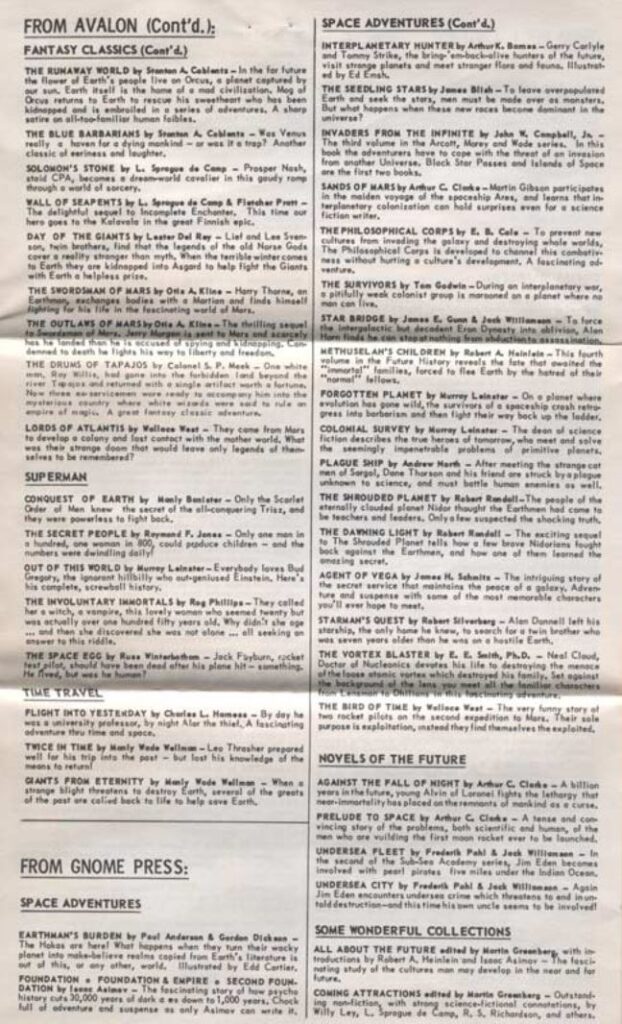
The 1963 catalog is a two-page mélange of a few remaining Gnome books plus a series of Edgar Rice Burroughs novels from Canaveral Press and paperback editions of classics like Oliver Twist. PICK-A-BOOK is not mentioned. KEMP’s copy was addressed to the Gotham Book Mart and bookstores were indeed the intended market, with steep discounts offered for orders of 100 or more books. How Greenberg pulled off these deals is not known.
Gnome catalogs are extremely scarce items in today’s market. Finding any of them would be a thrill for a collector. The thought that additional unrecorded ones might be out there tantalizes whenever an older collection comes on the market. If any are found, please let me know.

